The Numerical Simulation of the Pressure Law and Control of the Hard Roof Face in the Far Field
Abstract
:1. Introduction
2. Coal Rock Excavation and Hydraulic Fracturing Flow–Solid Coupling Theory
2.1. The Rock Stress Equilibrium Equation
- —Stress component.
- —The component of the outer normal vector, dimensionless.
- —Surface force component.
- —Displacement component.
- —The specified displacement component on the boundary.
- —The boundary of the force.
- —The boundary of the displacement force.
2.2. Fluid Seepage Equilibrium Equation
3. Engineering Background
4. The Stress Distribution Pattern of the Hard Top Plate
4.1. Numerical Model Construction
4.2. Analysis of the Numerical Calculation Results
4.3. Numerical Simulation Validation
5. The Reasonable Fracture-Weakening Step of the Hard Top Ground
- —refers to the volume mass of the rock layer above the working face.
- —denotes the thickness of the rock layer above.
- —the overlying rock layer number.
- —represents the average volume mass of the overlying rock.
- and —denote the support pressure coefficients.
6. The Numerical Simulation of the Prefabricated Fractures in Hard Top Slabs Using Ground Fracturing Technology
6.1. Establishing the Numerical Simulation
6.2. Analysis of the Numerical Calculation Results
7. Conclusions
- (1)
- The simulation results showed an initial hard top slab pressure step of about 52 m, with an error rate of 0.07% compared to the measured results, verifying the simulation’s accuracy.
- (2)
- A correlation analysis of the support strength equation was conducted using the control variable method to determine the relationship between the fracture prediction step and the support strength, identifying a fracture spacing range of 13–24 m.
- (3)
- A combined coal seam excavation and hydraulic fracturing numerical model was established. Fracture spacings of 16 m, 20 m, and 24 m significantly weakened the vertical stress at the coal seam working face when the roof broke, while the degree of reduction was mostly the same. The peak vertical stress occurred the furthest from the working face at the 16 m fracture spacing. Therefore, the pressure from the broken roof had the least impact on the working face, which was more conducive to safe mining practices.
Author Contributions
Funding
Conflicts of Interest
References
- Peng, J.; Jin, Z.; Bai, X. Fully mechanized coal mining under hard roof and hard seam conditions in Datong mining area. Coal Sci. Technol. 2004, 2, 1–4. [Google Scholar]
- Yu, B.; Gao, R.; Meng, X.; Kuang, T. Instability of underground pressure and control technology for large and near field structures. Chin. J. Rock Mech. Eng. 2018, 37, 1–12. [Google Scholar]
- Song, Y. Control Method and Engineering Effect of Hard Roof in Datong Coal Mine. Coal Sci. Technol. 1991, 12, 18–22. [Google Scholar]
- Zhang, Y.; Zou, Y.; Zhang, Y.; Wang, L.; Liu, D.; Sun, J.; Ge, H.; Zhou, D. Experimental Study on Characteristics and Mechanisms of Matrix Pressure Transmission Near the Fracture Surface during Post-Fracturing Shut-In in Tight Oil Reservoirs. J. Pet. Sci. Eng. 2022, 219, 111133. [Google Scholar] [CrossRef]
- Wang, J.A.; Li, D.; Shang, X. Mechanics analysis of creep fracture of strong roof strata above mined-out area. J. Univ. Sci. Technol. Beijing 2011, 33, 142–148. [Google Scholar] [CrossRef]
- Yan, S.; Ning, Y.; Kang, L.; Shi, Y.; Wang, Y.; Li, Y. The mechanism of hydro breakage to control hard roof and its test study. J. China Coal Soc. 2000, 25, 32–35. [Google Scholar]
- Huang, B.X.; Cheng, Q.Y.; Liu, C.Y.; Wei, M.T.; Fu, J.H. Hydraulic fracturing theory of coal-rock mass and its technical framework. J. Min. Saf. Eng. 2011, 28, 167–173. [Google Scholar]
- Chen, D. Characteristics and control technology of dynamic pressure on hard roof under goaf. Coal Sci. Technol. 2014, 42, 125–128. [Google Scholar]
- Yu, B.; Zhu, W.; Gao, R.; Liu, J. Overlying strata structure and action mechanism of large space stope in fully-mechanized top coal caving in extra-thick coal seam. J. China Coal Soc. 2016, 41, 571–580. [Google Scholar]
- Liu, J. Study on the Movement Law and Control Technology of Hard Roof in Thick Coal Seam Mining at High Height. Master’s thesis, China University of Mining and Technology, Beijing, China, 2015. [Google Scholar]
- Yu, B.; Duan, H. Research on roof control technology of hydraulic fracturing in high-strength fully mechanized caving mining of extra thick coal seam. J. Rock Mech. Eng. 2014, 33, 778–785. [Google Scholar]
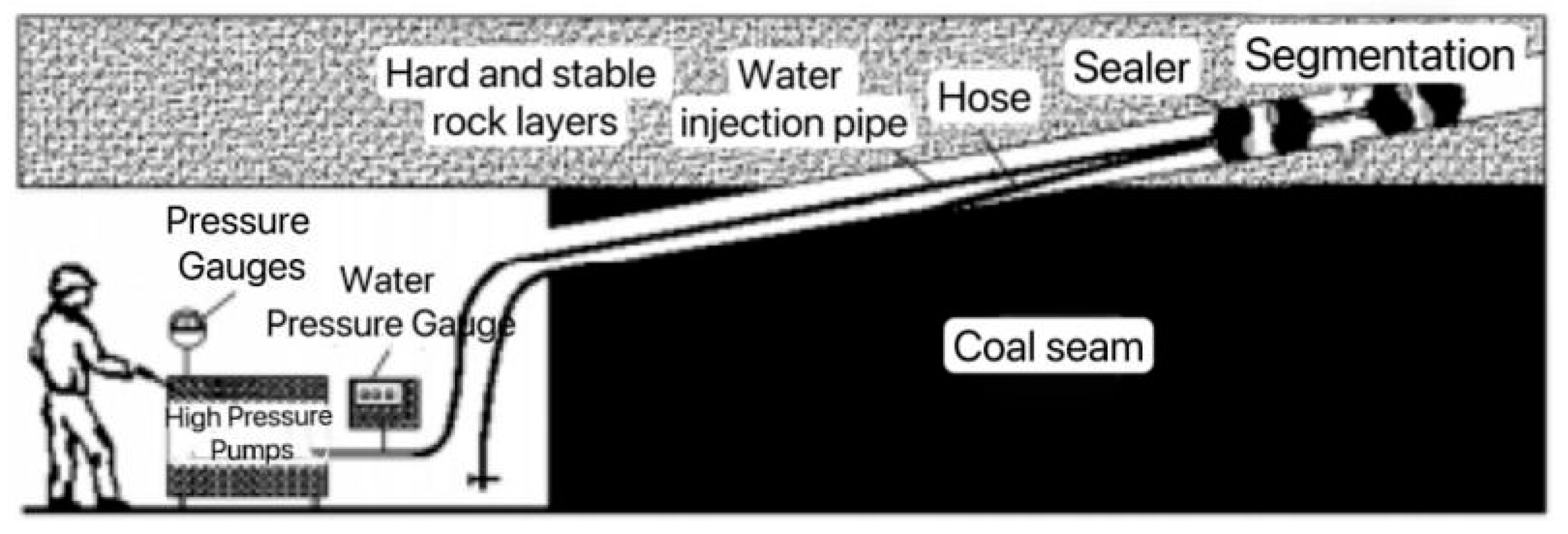
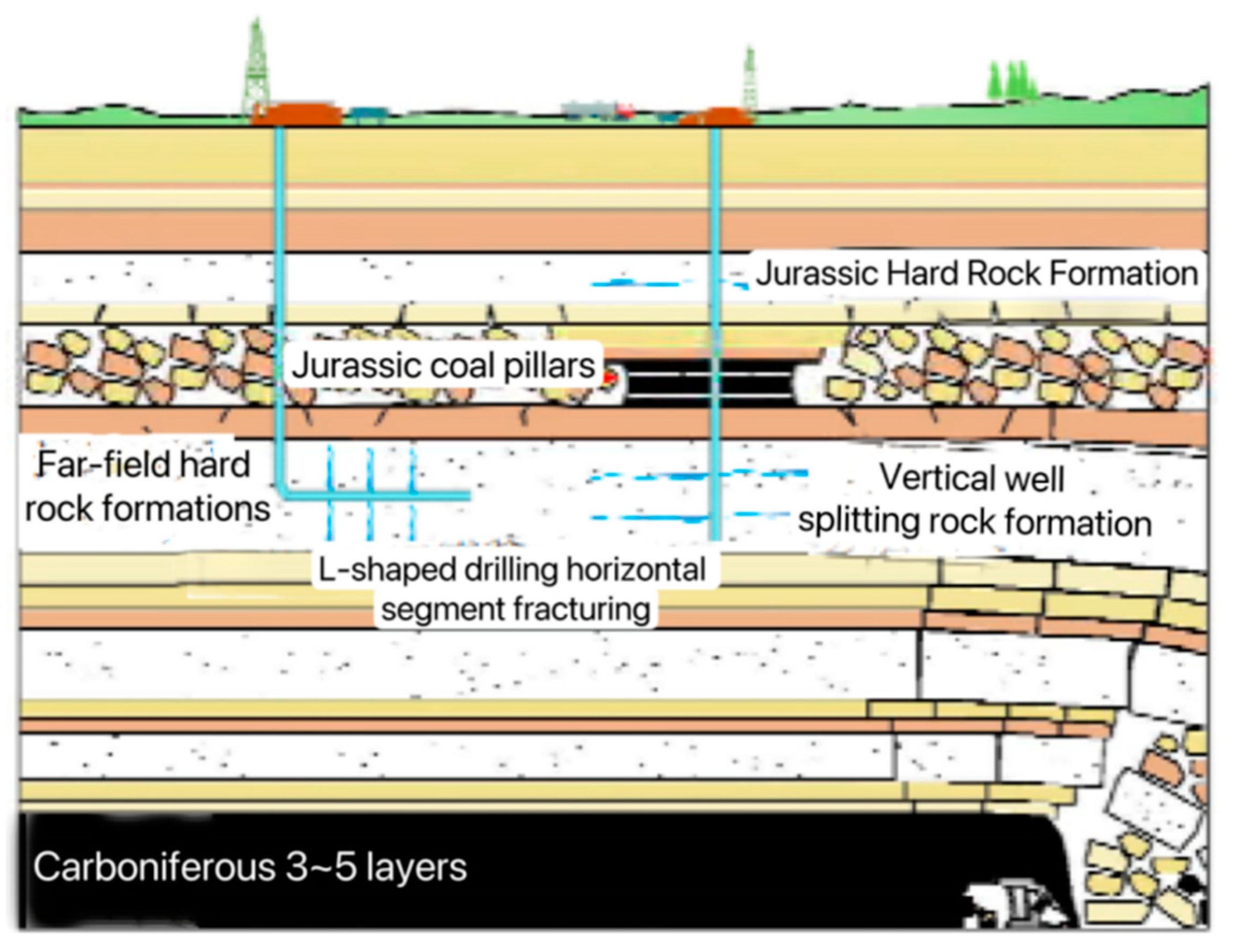


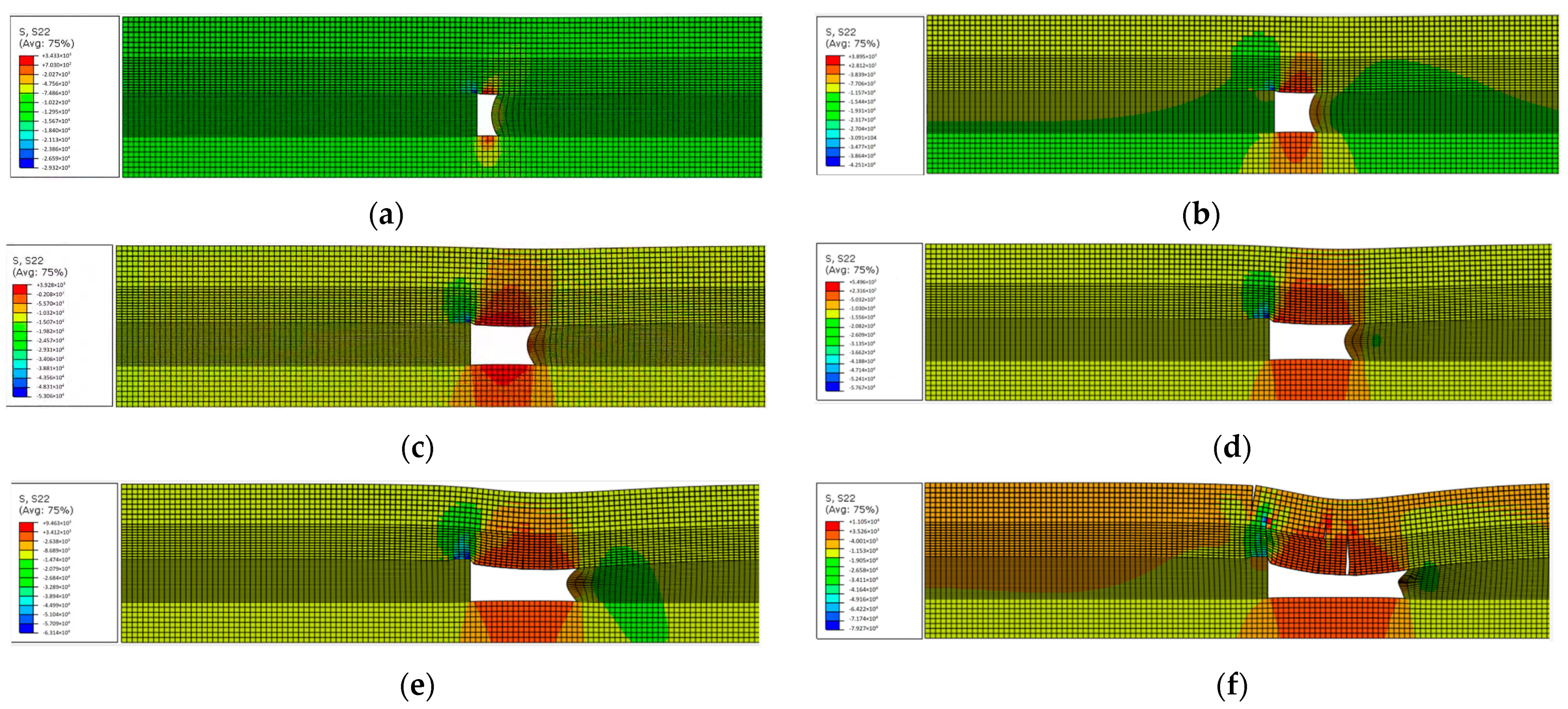
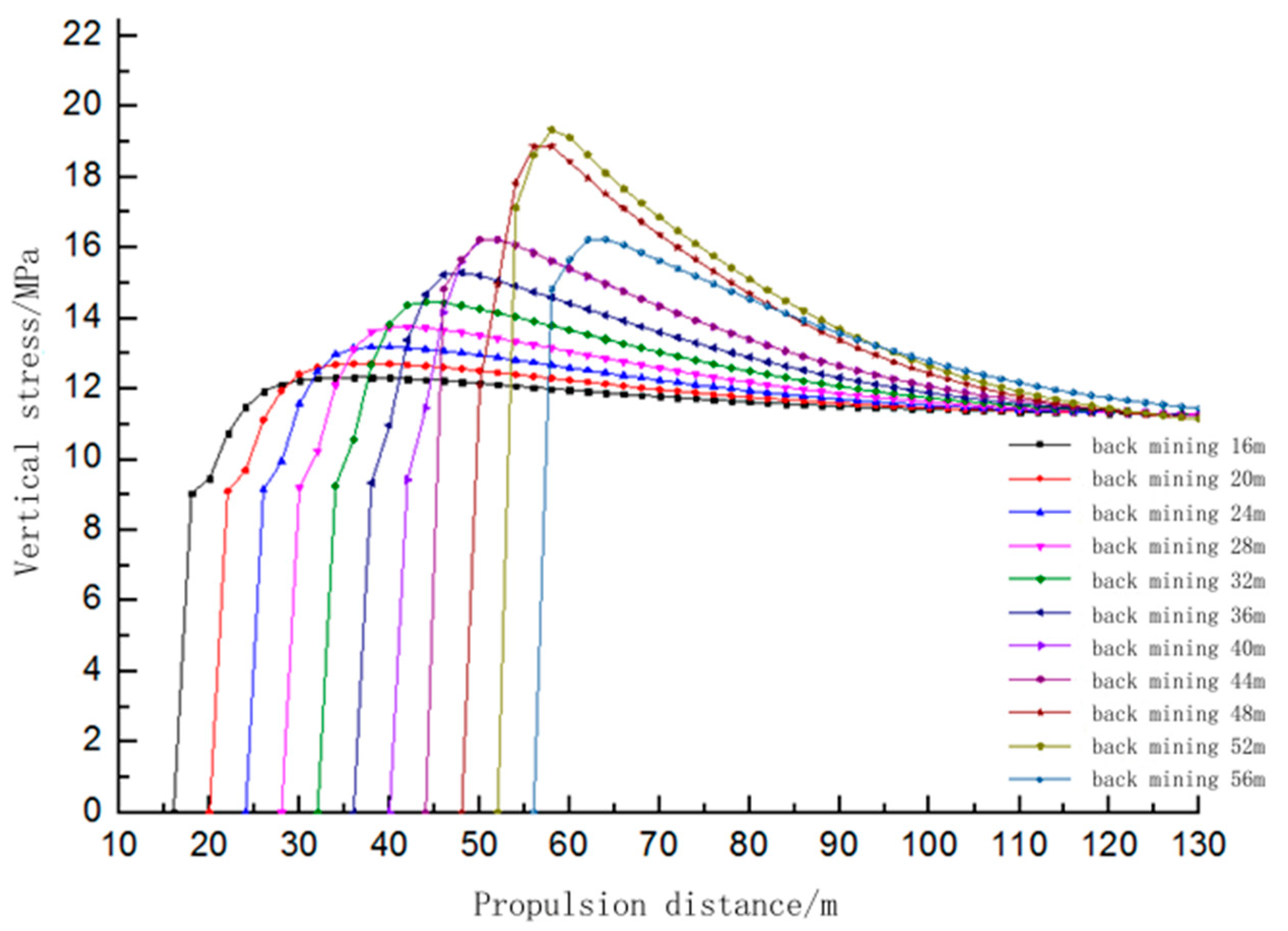


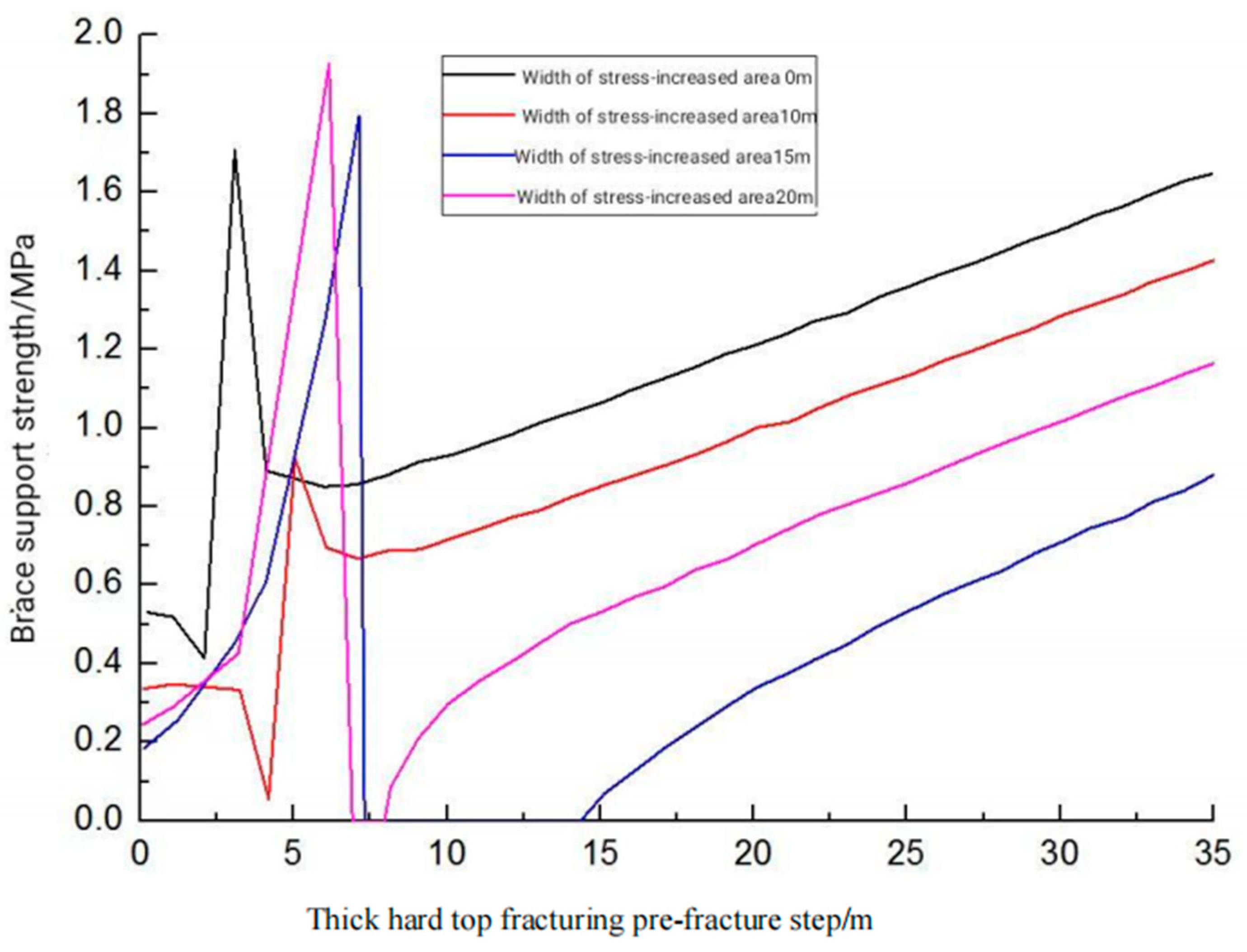




| Lithology | Thickness/m | Modulus of Elasticity/MPa | Poisson’s Ratio | Cohesion/MPa | Angle of Internal Friction/° | Tensile Strength/MPa |
|---|---|---|---|---|---|---|
| Main roof | 15.11 | 52,500 | 0.24 | 11.30 | 34.22 | 9.36 |
| Immediate roof | 12.52 | 20,000 | 0.20 | 4.50 | 40 | 4.5 |
| Coal seams | 16 | 10,500 | 0.22 | 1.20 | 38 | 3.3 |
| Baseboard | 13.74 | 12,500 | 0.16 | 3.20 | 20 | 3.4 |
| Working Surface Location | First Time to Press the Step Distance/m | Initial Incoming Dynamic Load Factor | Average Period to Pressure Step/m | Average Period to Ballast Load Factor | Working Surface Location | ||
|---|---|---|---|---|---|---|---|
| 11# | 51.6 | 1.59 | 22.3 | 1.58 | 11# | ||
| 22# | 51.6 | 1.85 | 22.3 | 1.65 | 22# | ||
| Machine head | 33# | 51.6 | 1.82 | 21.8 | 1.66 | Machine head | 33# |
| 44# | 51.6 | 1.68 | 22.0 | 1.59 | 44# | ||
| 55# | 51.6 | 1.36 | 20.6 | 1.36 | 55# | ||
| Middle | 66# | 51.6 | 1.54 | 20.7 | 1.59 | Middle | 66# |
| 77# | 51.6 | 1.75 | 20.6 | 1.82 | 77# | ||
| 88# | 51.6 | 1.82 | 18.9 | 1.81 | 88# | ||
| 99# | 51.6 | 1.95 | 18.8 | 1.89 | 99# | ||
| Tail | 110# | 51.6 | 2.18 | 18.9 | 1.95 | Tail | 110# |
| Average | 51.6 | 1.75 | 20.69 | 1.69 | Average | ||
| Fracturing Parameters | Basic top Modulus of Elasticity/GPa | Poisson’s Ratio | Tensile Strength/MPa | Permeability Coefficient/m/s | Fracturing Fluid Viscosity/mPa.s | Peak Displacement m2/s | Pore Pressure/MPa |
|---|---|---|---|---|---|---|---|
| Numerical value | 5.25 | 0.24 | 9.36 | 1 × 10−7 | 1 × 10−14 | 0.02 | 20 |
Disclaimer/Publisher’s Note: The statements, opinions and data contained in all publications are solely those of the individual author(s) and contributor(s) and not of MDPI and/or the editor(s). MDPI and/or the editor(s) disclaim responsibility for any injury to people or property resulting from any ideas, methods, instructions or products referred to in the content. |
© 2023 by the authors. Licensee MDPI, Basel, Switzerland. This article is an open access article distributed under the terms and conditions of the Creative Commons Attribution (CC BY) license (https://creativecommons.org/licenses/by/4.0/).
Share and Cite
Wei, Y.; Jiang, M.; Zhao, X.; Zhao, X.; Dong, K. The Numerical Simulation of the Pressure Law and Control of the Hard Roof Face in the Far Field. Sustainability 2023, 15, 11285. https://doi.org/10.3390/su151411285
Wei Y, Jiang M, Zhao X, Zhao X, Dong K. The Numerical Simulation of the Pressure Law and Control of the Hard Roof Face in the Far Field. Sustainability. 2023; 15(14):11285. https://doi.org/10.3390/su151411285
Chicago/Turabian StyleWei, Yuyang, Minzheng Jiang, Xinyu Zhao, Xinrui Zhao, and Kangxing Dong. 2023. "The Numerical Simulation of the Pressure Law and Control of the Hard Roof Face in the Far Field" Sustainability 15, no. 14: 11285. https://doi.org/10.3390/su151411285




